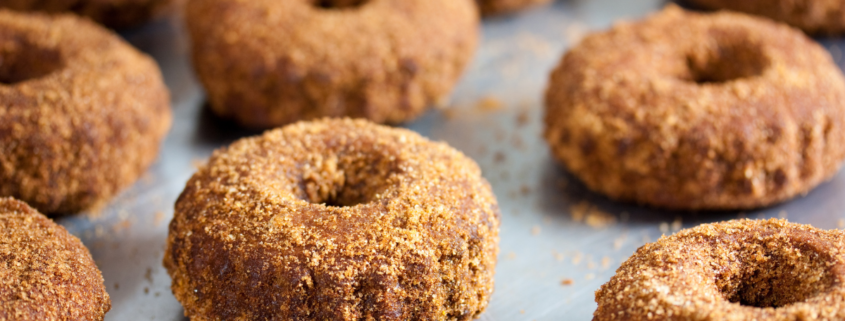The Science of Vegan Baking
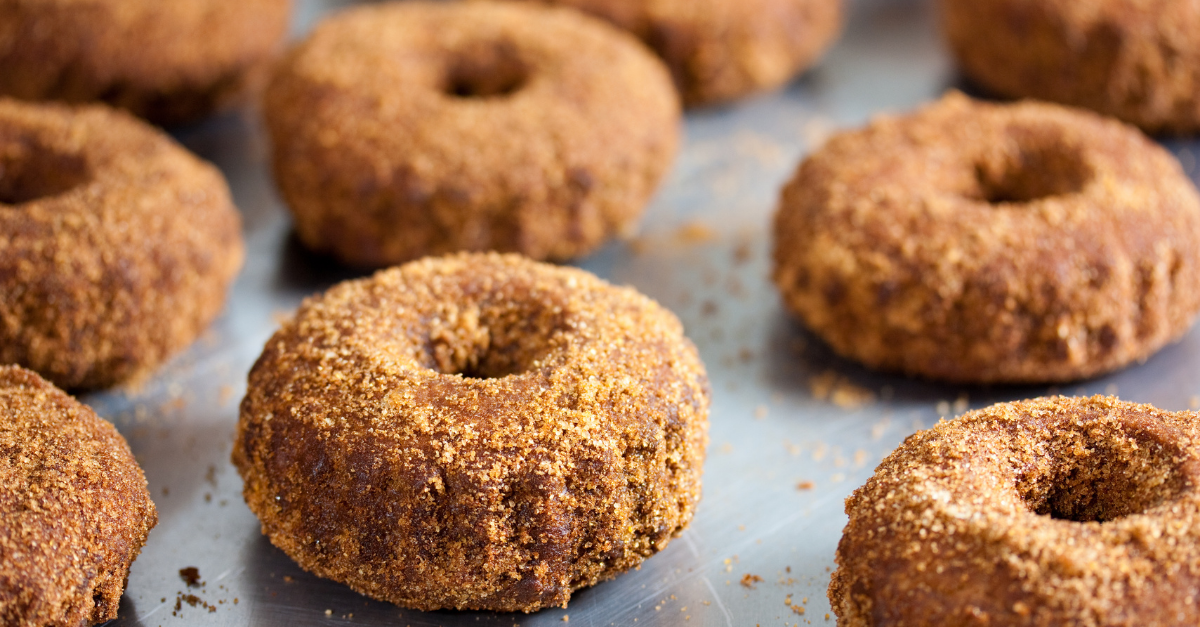
Tray of freshly made vegan apple cider doughnuts
By Dené Voisin
By 9 PM on a Thursday night, most businesses in Atlanta’s Historic West End have already closed for the night. Business is still buzzing for Vegan Dream Doughnuts, located across the street from the Mall at West End. One bite into their gluten-free, mouth-watering donuts explains it all. They’re bursting with flavor, surprisingly light, and made without any refined sugars. Most importantly for vegans, they’re made without any animal products. Nearing midnight, there is still a steady flow of customers, confirming something that those of us without dietary restrictions might overlook- vegans have a sweet tooth too. Founder and self-taught chef Ras Izes is committed to filling that need without the excess calories and refined sugars that have come to define one of America’s staple breakfast items. “It brings people together, like, you can’t hate a donut,” he states, readjusting the quickly disappearing stock of donuts in the display case. As a Rastafarian for most of his adult life, Izes only eats ‘ital’ (plant-based) foods and has found a passion in creating delicious dishes and donuts that can be enjoyed by everyone – vegan or not.
Plant-based power
According to a Forbes magazine article, the number of American consumers identifying as vegan grew 600% between 2014 and 2017. A release from PlantBasedFoods.org stated that plant-based food sales grew 8.1% from 2016-2017, highlighting the growing market for vegan-friendly foods. This trend has been accompanied by an increase in Google searches for ‘vegan baking’ over the last decade with upticks especially around the holiday season.
“It brings people together, like, you can’t hate a [vegan] donut.” – Ras Izes
Making your grandmother’s famous German Chocolate Cake or your uncle’s buttery breakfast croissants completely plant-based may seem like a futile task, but many blogs and websites specialize in the delicate food science of swapping out animal products without sacrificing taste and texture. Vegan baking can be a highly experimental endeavor, but understanding the science behind how milk, butter, and eggs function in baking can ease the journey to sweet, sweet success.
Move over, milk!
In recipes that require milk, its primary functions are usually moisture, sweetness, and structure. “I’m not sure milk is 100% necessary in the way that it has to be (cow’s) milk,” says baker Ashley Hay. She says it’s not that common of an ingredient in recipes and it’s much easier to replace. Hay adds, “It does have some flavor and fat content, but mostly I think it’s there for the liquid content.” A 13-year veteran baker and head decorator at Publix bakery, Ashley helps make between 15-30 full-sized cakes a day, plus smaller items like pies, tarts, and macarons.
When its role is moisture, milk forms gluten chains with the flour to give the cake structure- a function easily filled by accessible milk alternatives. “In a box (cake) mix, they call for water, not milk,” she says. On replacing milk, Ashley notes that looking for an alternative that matches the fat content of the dairy in a recipe is a quick and simple swap out.
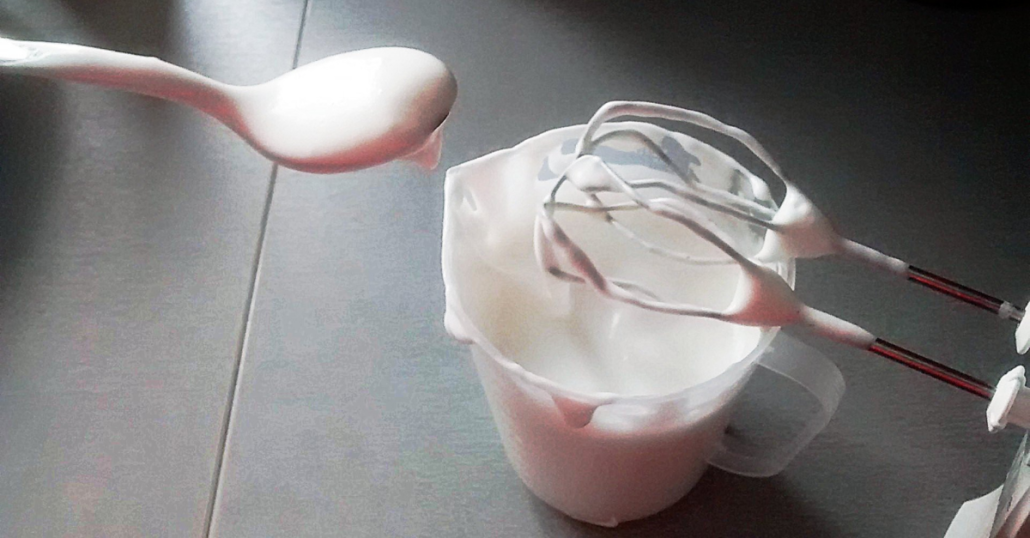
Aquafaba is made from leftover water in canned chickpeas and can be whipped into a meringue and flavored for desserts.
Heavy cream, which is higher in fat content, is mainly used in toppings as a base for whipped cream. Ashley mentions that aquafaba, the water leftover in canned chickpeas, can be whipped into stiff peaks and flavored for desserts. Non-dairy whipped toppings are becoming increasingly popular in major grocery chains, with options like ready-to-pipe coconut milk and nut-milk whipped toppings already hitting shelves around Atlanta.
Butter, y’all?
From breakfast to dessert, butter is a key ingredient for decadent cakes and flavorful rolls to fluffy biscuits and flaky croissants. Butter and other fats function as ‘shortenings’ whose function is to ‘shorten’ the formation of gluten protein when flour is mixed with moisture. This prevents the elastic structure and resulting chewiness of breads when a ‘melt in the mouth’ feel is the desired outcome. For Ras Izes at Vegan Dream Doughnuts, coconut flour provides him a soft, ‘melt-in-your-mouth’ donut, free of the gluten chains that would require additional fats. Coconut flour is derived from the flesh of coconuts and contains a fair amount of saturated fat already. It is likely that the absence of gluten and the presence of this fat gives coconut flour a shortcut to ‘shortening’, reducing the need for additional calories while preserving the crumbly mouthfeel many recipes aim for.
For some kinds of cakes and cookies, vegetable oil, ground flaxseed, and even avocado can shorten just as well, but for many recipes, the swap is not so simple. That is because butter functions differently in a bake depending on its temperature. For example, pastries like croissants require butter to be cold and solid.
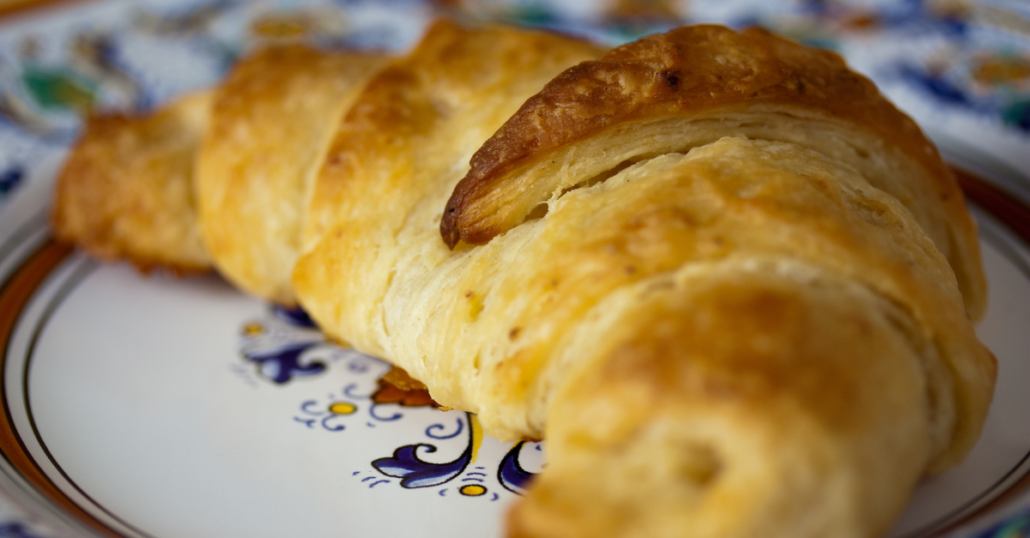
Vegan croissants can be just a fluffy as those containing eggs
“You want the butter to laminate and form really thin alternating layers with the flour…so that you’ll have long gluten strands folding around the butter,” Hay says. Butter contains moisture, so if it is warm when folded into pastry, it can melt and seep into other ingredients rather than form layers, resulting in a bready, chewier croissant. “That’s why the butter has to be cold. When the croissant is baked, the butter will melt and flavor the dough, and the moisture will evaporate into steam and lift the pastry on its way up.”
Recipes call for melted butter when they need fat, flavor, and very short gluten chains. However, most cake recipes rely on creaming room temperature butter with sugar before folding in additional ingredients. The creaming method is the process of aerating the butter so that it fills with air bubbles that capture the gases, making it fluffy and creamy. In non-yeasted cakes, their fluffiness derives from this trapped air- expanding as it heats in the oven. Ashley says, “The oil-based cakes are really tender, flat cakes, and they don’t rise the same way that creamed cakes with butter rise.”
Uncracking eggs
Eggs are among the hardest ingredients to replace because the jobs they do are so integral to the structure of most bakes. Eggs create stability within a batter, help thicken and emulsify sauces and custards, and can even act as a glue or a glaze. Aeration is one of eggs’ most important roles. Whisking traps air bubbles in the liquid egg product, which are surrounded by egg proteins like ovalbumin and ovomucin. These proteins are responsible for the fluffy stiff peaks that precede meringues and souffles. Ovalbumin helps trap those essential air bubbles during whipping while ovomucin has the elastic qualities needed to encase the air while the heat of baking forces it to expand. This expansion is needed for the fluffy, light texture that keeps cakes from feeling stodgy and dense in your mouth. Luckily, there are options like aquafaba that can mimic this effect. Aquafaba meringue recipes also suggest that this egg substitute handles heat well and maintains stability when baked.
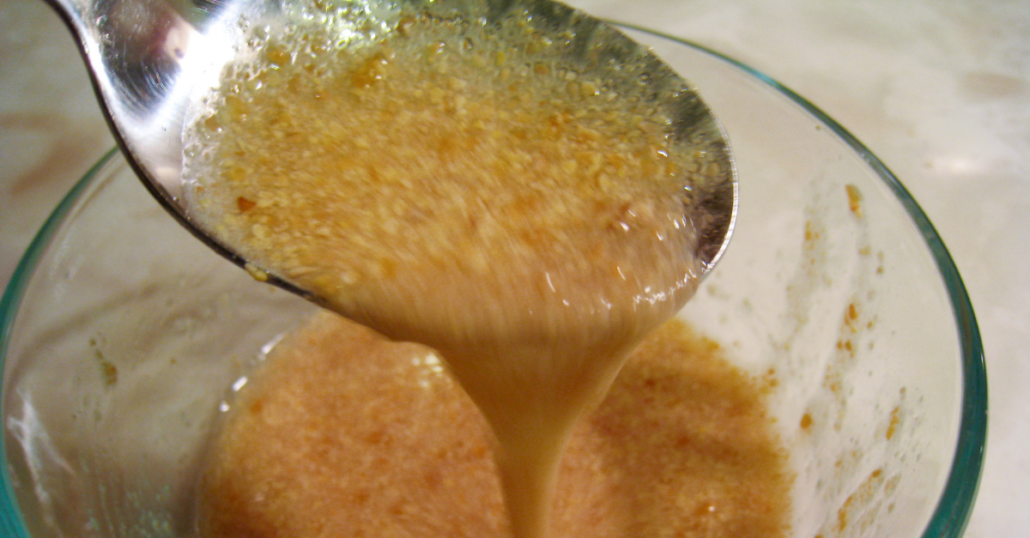
Flaxseed can be used as an egg substitute
Eggs also contain proteins like lecithin which are amphiphilic, meaning they have a water-loving and water-hating end. These opposing ends bind to oil and water in a mixture, reducing the surface tension between the two liquids, making mixtures more cohesive and less likely to separate. Soy and sunflower lecithin are becoming more commercially available. Usually found in the ingredient list of things like chocolate and peanut butter, soy lecithin is a popular industrial emulsifier that is plant-based and useful for mixes with added fats. Ground flaxseed and soaked chia seeds can also function as emulsifiers, though they may result in a chewier texture and slightly nutty flavor. Because of their versatility in recipes, replacing eggs may require a bit of creativity to make sure that the moisture, texture, and taste they bring to recipes will not be missed.
For at-home bakers, learning about ways to make their favorite baked goods without the animal products they once relied on can be an exciting and experimental process. For people who still eat dairy and meat, plant-based swaps can help reduce calories and fat in many recipes, which can positively impact health, while also being more inclusive of people who may have dietary restrictions. Either way, plant-based vegan baking alternatives can help everyone have their cake and eat it too.
Thank you to Peter Antonovich and the East Point Velodrome Association! To learn more about upcoming track cycling events and training, visit https://www.dicklanevelodrome.com.
For more Awesome Science of Everyday Life features and other science updates, follow Science ATL on Facebook, Twitter, and Instagram!
References:
https://lifehacker.com/the-science-of-baking-in-one-graphic-1773384162
https://www.thekitchn.com/the-science-behind-whipping-egg-whites-in-copper-bowls-221943
https://www.aeb.org/food-manufacturers/egg-functionality/aeration-foaming-structure
https://fasteasybread.com/why-and-how-to-use-lecithin-in-baking-and-cooking/
https://www.americastestkitchen.com/guides/vegan/what-is-aquafaba

